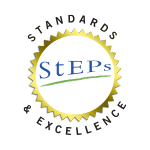 Exciting changes are happening at the nearly 1,000 organizations taking part in the StEPs program (Standards and Excellence Program for History Organizations).
Exciting changes are happening at the nearly 1,000 organizations taking part in the StEPs program (Standards and Excellence Program for History Organizations).
Our “StEPs Spotlight” blog series highlights accomplishments by participating organizations.
Below is another example of how StEPs is helping organizations take a leap forward by improving policies and practices, opening lines of communication, and setting goals for a bright future.
Geneva History Museum
Geneva, Illinois

In 1943, dedicated citizens formed the Geneva Historical Society to preserve local history and educate the community. Artifacts were cataloged and stored in private residences and exhibited in storefronts. A Museum Committee was formed in 1961 to raise funds for a building, and after years of considering existing buildings, they made a deal with the park district and city to build the first Geneva History Museum in Wheeler Park. This building was expanded twice, in 1972 and in 1990.
As newcomers began to outnumber long-time residents, the historical society recognized the need for flexible space and a more central location. In 2004, the organization, renamed the Geneva History Center, conducted a successful capital campaign to purchase a two-story building in the heart of Geneva’s historic district. The building was renovated to create two exhibition galleries, storage areas for collections and archives, a research room, a meeting room, and offices. The organization has always operated through voluntary donations and does not receive public funds. In 2013, while participating in the Museum Assessment Program, it was rediscovered that the word “museum” best represents the activities and services of the organization. In June 2014, the name became the Geneva History Museum, operated by the Geneva Historical Society.

The Museum celebrated ten years in this building in August 2014 with a grand reopening of the redesigned Main Gallery, “Geneva’s Story,” our permanent exhibition. These facilities, combined with multiple award-winning exhibits, educational programs, cutting-edge research, and dedicated volunteers, continue to make the Geneva History Museum a source of great community pride. With five paid staff members and eighty volunteers, GHM joined AASLH in 1987 and has been working through the StEPs program since 2014.
Tell us how your organization is making its way through the program.
We set a schedule of regular weekly meetings on Monday mornings from 9 a.m. to noon since the Museum is closed to the public on Mondays. The committee consisted of all staff members and the President of the Board of Directors. All Board members were invited to participate at any time if they wanted to join in the discussion. We used a laptop, projector, and screen to display the pages of the workbook for all to read together. The Executive Director acted as moderator, kept notes from each meeting, and checked off the level of each standard in the workbook. At the end of each section the committee went back through the standards to see where we ranked. Notes were gathered on what needs to be completed to increase the level of standard and who would be responsible for that area.

What would you say is the most significant change or improvement within your organization as a result of taking part in StEPs?
Having the entire staff act as part of the committee raised awareness at all levels of best practices. We were very proud to earn a gold certificate for our level of Interpretation and all involved now have a sense of wanting to make the necessary improvements to resubmit for a higher level in all of the other areas. Our participation in StEPs made us set aside a time to look at the “big picture” of the Geneva History Museum. With a small staff and limited budget, it is easy to get stuck in day-to-day activities and not take the time to plan and set policies and procedures. StEPs gave us a guide to start this process and with our notes from each section, we now have goals for improvement. The StEPs certificates have been framed on a wall in our lobby as a visual for all to know what the museum is doing to better serve the community.

Has your organization been able to use StEPs as leverage in fundraising or in other ways?
Displaying the StEPs certificates and sending press releases out has been a great way to share with the community how our museum ranks from the standards set by a national organization. Sharing our story of meeting each level of performance demonstrates that the Geneva History Museum is dedicated to a continuum of excellence. We have also participated in two Museum Assessment Programs with the American Alliance for Museums. It has been helpful to see similar information develop from both MAP and StEPs to confirm what needs to be done and assist with setting goals.

What advice do you have for organizations just starting in StEPs?
Set regular meeting times so that the workbook doesn’t just sit on your desk collecting dust. Keep notes on why your committee ranked each standard as basic, good or better so you can then make a list of what is needed to be done. When items on your list have been accomplished, go back and review your notes and check the performance indicators to see if you have reached a higher level.



